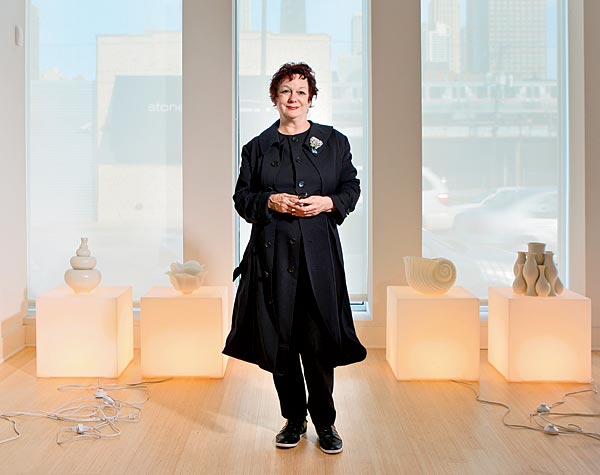
A few of her favorite things: June Blaker in the main gallery of her River North shop. The flower and seashell Illuminated Candles are flanked by porcelain clustered vases.
June Blaker has been influencing this town’s style cognoscenti for decades with her visionary approach to everything from fashion to furniture. At City, the lifestyle emporium she ruled with Barry Bursak through the 1980s, she introduced Chicago to Japanese clothiers Rei Kawakubo and Yohji Yamamoto, a fledgling industrial designer named Philippe Starck, and the aggressively playful furniture of the Milanese collective Memphis—all to a Ryuichi Sakamoto–flavored soundtrack. When City morphed into Luminaire in 1989, Blaker went solo, focusing on fashion and accessories (including the intricate beaded jewelry she creates) in her eponymous shop on a sunny corner of River North. The cutting-edginess of that neighborhood eventually began to smooth over, and in 2001 Blaker took a break from retail to concentrate on her art and on styling clients who had come to rely on her unerring eye. Flash-forward six years: Blaker busted out all over again with a hip new store (June Blaker, 870 N. Orleans St., 312-751-9220; juneblaker.com). We checked in with the tastemaker to see how things are going in her current incarnation.
You seem more interested in home than fashion these days. Fashion used to be intellectual and exciting, but now it’s all about the money, and I’m not interested in that. When I saw what Comme des Garçons did for H&M, I was so glad I wasn’t in the clothing business anymore. A lot of designers just seem to want to cash in. There are more creative things going on with home design and accessories these days.
Where do you find merchandise, and what are you looking for? I still try to go to all the trade shows, but it’s expensive to travel and the dollar isn’t very strong. I’ve been finding a lot of great American designers and craftsmen in New York and elsewhere. I’m not looking to go into furniture—that’s being done very well in Chicago already—but I had to have the Lucite chairs and benches that Karim Rashid did for Umbra, and dimmable light columns and benches by Pablo Pardo. I’m always looking for odd things, whatever catches my eye.
Do you handle many Chicago artisans? Yes. I’ve known Philip Cantrell for years and love his mosaic pieces and jewelry. He also finds great vintage pieces, like a Murano glass handbag/ vase, so I show some of that, too. Gillion Carrara is an amazing metalsmith who teaches at the Art Institute. She incorporates exotic woods in her objects and jewelry, and lately has been working a lot in lead crystal.
And your own work has quite a following. Making beaded pieces has definitely influenced my appreciation of other artists, and what I choose to display and sell. Look at the detail in these candlesticks—a gearhead in Indiana assembles machine parts and cogs to make sculptural, intricate neo-gothic works of art. I found him at the 57th Street Art Fair.
What about the mounted bugs? I was one of the first to have these in Chicago, and they’ve become a signature item for me. There are cheap versions available, but you have to be concerned with how and where they are harvested. These specimens come from eco-friendly reserves around the world that don’t poach or deal with endangered species. The color is not enhanced, and they’re mounted between glass with just a dab of glue in a pristine black frame, so they appear to float. People love the butterflies.
What else is coming up? I’m crazy about these Adam Frank light systems, which project windows and simulated sunshine on a wall. There are replaceable slides that mimic tree branches, and you can adjust a little fan to make them appear to flicker in the breeze. Fantastic.
You seem to know everybody who comes in the door. Well, I’ve been in the business a long time, and this is a destination location—not a lot of street traffic. It’s great to see friends stop by, talk about design, and meet interesting people. I want to know everyone.
Photograph: Katrina Wittkamp


